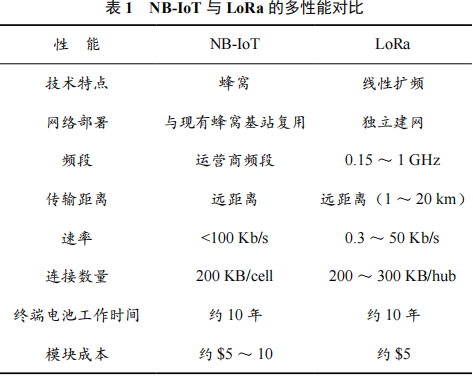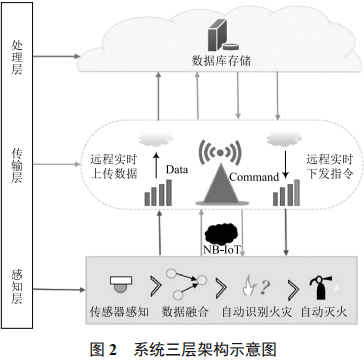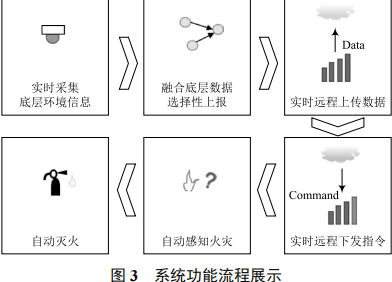Qin Licheng, Chen Fulon, Cheng Guihua, Liu Zhichao, Xiong Kun, Wang Xuyang, Gao Anke
(Anhui Normal University, Wuhu, Anhui 241002)
Abstract: Fire safety, as part of urban public safety, is related to the safety of people’s lives and property and social stability. Due to the weak real-time monitoring in manual monitoring processes, smart fire safety has emerged. This article mainly introduces a smart fire technology that combines NB-IoT and LoRa, using multiple sensors to collect on-site environmental data, issuing fire warning commands via LoRa, achieving real-time monitoring and handling of fire situations, and feeding results back to the Web and WeChat mini-programs; combining database storage with human intervention for easier management by administrators.
Keywords: IoT Applications; Fire Monitoring; Microcontroller; NB-IoT; LoRa; Smart Fire Safety
Classification Number: TP27 Document Identification Code: A
Article Number: 2095-1302(2022)09-0020-04
0 Introduction
With the rapid development of China’s economy and the increasing living standards of the people, more and more people are becoming aware of the importance of fire safety. In recent years, due to strong government policy and funding support for fire safety management, the gradual introduction of laws and regulations, and the increasingly perfect and standardized fire technology, there has been significant progress in the production technology of fire warning and handling facilities. As IoT technology gradually develops and matures, the underlying sensing technology becomes increasingly refined, and the information transmission of wireless transmission devices becomes more stable and diverse (such as LoRa, NB-IoT, etc.), while the functions of smart terminal devices continue to strengthen, smart fire safety has emerged as a result.
Smart fire safety refers to the use of the latest technologies such as IoT and mobile “Internet +” in conjunction with big data cloud computing platforms and intelligent fire alarm applications to achieve the intelligentization of urban fire safety, improve the efficiency of information transmission, ensure the integrity of fire facilities, enhance law enforcement and management effectiveness, strengthen rescue capabilities, and reduce the probability and losses of fire incidents. As a new direction for the development of the fire industry, smart fire safety has good social benefits and application prospects in providing data support for fire prevention supervision and management, improving the level of socialized fire supervision and management, and enhancing the comprehensive fire prevention capabilities of modern smart cities.
1 Analysis of Advantages and Disadvantages of NB-IoT and LoRa
1.1 Advantages and Disadvantages of NB-IoT
NB-IoT (Narrow Band Internet of Things) is an emerging technology based on cellular narrowband IoT in the IoT field, supporting low-power devices’ cellular data connections in wide area networks, also referred to as Low Power Wide Area Network (LPWA). The NB-IoT technology, based on ultra-narrowband, repeated transmission, simplified network protocols, etc., sacrifices certain rates, delays, and mobility to acquire the carrying capacity aimed at low-power wide-area IoT [5-7]. The main advantages are:
(1) Massive Access: Under the same base station coverage conditions, NB-IoT technology can access 50 to 100 times more devices than other wireless technologies, ensuring access for 100,000 terminals per sector.
(2) Low Power Consumption: For many battery-powered devices and environments, the low power characteristics of NB-IoT can ensure device endurance, greatly increasing from months to years, significantly reducing the inconvenience caused by frequent battery replacements.
(3) Strong Coverage: The coverage capability of NB-IoT is 100 times that of LTE, which can meet the wide-area coverage needs in sparsely populated areas and is also suitable for underground applications requiring deep coverage.
(4) Low Cost: Due to the use of cellular network technology on authorized frequency bands, NB-IoT does not require re-networking, and RF and antennas can generally be reused; combined with the low power, low bandwidth, and low rate characteristics of NB-IoT, it also reduces chip and module costs.
At the same time, NB-IoT also has the following disadvantages:
(1) Low Data Transmission: Based on low power consumption, NB-IoT can only transmit a small amount of data.
(2) High Communication Costs: In addition to the price of NB-IoT communication modules, operators will also charge operational fees.
(3) Immature Technology: Although NB-IoT technology is widely applied, various faults often occur in practical applications, leading to communication interruptions.
(4) Platform Integration Issues: Telecom’s IoT platform uses the CoPA protocol, which is complex for integration, and to be compatible with traditional TCP and UDP communications, often results in prolonged construction times.
As Chinese enterprises hold more NB-IoT technology patents, the country is more inclined to develop NB-IoT from a policy perspective. The Ministry of Industry and Information Technology has released a construction plan for NB-IoT, stating that over 1.5 million NB-IoT base stations will be built in the country before 2020, with connections exceeding 600 million. Therefore, NB-IoT is environmentally friendly in China.
1.2 Advantages and Disadvantages of LoRa
LoRa (Long Range Radio) is a low-power local area wireless standard created by Semtech, characterized by achieving longer transmission distances under the same power conditions compared to other wireless methods, unifying low power consumption and long range. It can expand the communication distance by 3 to 5 times compared to traditional wireless RF communications [8-10]. The LoRa network mainly consists of terminals (which can have built-in LoRa modules), gateways (or base stations), network servers, and application servers, with bidirectional data transmission; terminal nodes can be various devices, such as water meters, gas meters, smoke detectors, pet trackers, etc. The LoRa terminal nodes for this project are various sensors, which connect through LoRa wireless communication gateways; then through 4G networks or Ethernet, connect to the network server. The LoRa gateway communicates with the network server via TCP/IP protocol.
The LoRaWAN network architecture is a typical star topology, in which the LoRa gateway acts as a transparent transmission relay, connecting terminal devices and backend central servers. Terminal devices communicate with one or more gateways through single hops, and all nodes and gateways communicate bidirectionally.
LoRa networks feature long transmission distances, low operating power, numerous network nodes, strong anti-interference, and low cost, making them widely applicable in life, including smart buildings, smart industry, smart logistics, etc. However, it also has the following disadvantages: (1) As LoRa continues to develop, the increasing number of devices and networks leads to some frequency interference among them; (2) During the deployment of LoRa, users need to build their own networks; (3) LoRa has a small effective payload for data transmission, with byte limitations.
This project combines NB-IoT and LoRa deployed at the transmission layer to transmit information, differing from 3G/4G and WiFi in that NB-IoT and LoRa are low-power wide-area networks, which are IoT communication technologies that can achieve low bandwidth, low power consumption, long range, and massive connections. In this project, both are used as a full series of IoT detectors. A multi-performance comparison of NB-IoT and LoRa is listed in Table 1.


2 System Model
The system design framework can be described as a three-layer structure: sensing layer, transmission layer, and processing layer, as shown in Figure 2. The system uses various sensors such as temperature and humidity, smoke, combustible gas, and infrared to collect on-site data. The terminal nodes send the collected data to the gateway nodes in a timely manner, which will fuse and perform simple processing on the data, then selectively send it to the cloud server via remote transmission. When the computing results exceed the emergency fire warning threshold, the microcontroller automatically initiates the fire extinguishing event, driving the relay to open the fire extinguishing device, etc., to extinguish the fire. To facilitate observation, various data are displayed in real-time using webpages and WeChat mini-programs. This project combines LoRa and NB-IoT wireless communication modules to solve the practical problem of poor communication signals in scenarios like underground garages.

2.1 Sensing Layer
Terminal nodes connect devices: temperature and humidity sensor, smoke sensor, gas sensor, one LoRa, and multiple relays.
The sensing layer mainly connects multiple sensor devices through the microcontroller for real-time monitoring of the field environment, while connecting one LoRa as a wireless transmission module for interaction between nodes. Fire extinguishing devices such as fire bombs and sprinklers are equipped on-site, connected to the microcontroller via relays as switches. If a fire occurs, the microcontroller collects data from the sensors that exceed the alarm threshold, immediately processes the fire event, issues fire warning commands via LoRa, and drives the fire extinguishing devices within its jurisdiction to extinguish the fire.
2.2 Transmission Layer
Gateway nodes connect devices: one LoRa and one NB-IoT.
The transmission layer mainly conducts remote information exchange between the field and the cloud server, divided into uplink and downlink links. In the uplink, terminal nodes send their collected data to the gateway nodes via LoRa, while the LoRa on the gateway node is used to receive data sent from each node; the NB-IoT establishes a UDP connection with the cloud server, sending the integrated and processed data to the cloud server. In the downlink, the NB module establishes a UDP connection with the cloud server, which sends instructions to the NB module, and after receiving the instructions, it is handed over to the gateway node to send the corresponding instructions to the respective terminal nodes via LoRa.
2.3 Processing Layer
The processing layer mainly stores and processes the data received by the gateway nodes in real-time, and feeds back the processing results to the Web or the WeChat mini-programs of terminal devices, facilitating real-time processing by administrators.
3 System Functions
3.1 Product Function Application Process
The main functions of the project system include real-time collection of underlying environmental information, selective reporting of fused underlying data, real-time remote data uploading, real-time remote instruction issuing, automatic fire detection, and automatic fire extinguishing, as shown in Figure 3.

(1) Real-time collection of underlying environmental information: The project uses various sensors such as temperature and humidity, smoke, and gas to collect on-site data, with sensors playing a role in real-time monitoring of environmental data.
(2) Selective reporting of fused underlying data: Terminal nodes send the collected data to the gateway nodes in a timely manner, which will fuse and perform simple processing on the data, then selectively send it to the cloud server via remote transmission, aiming to reduce energy consumption and latency as much as possible.
(3) Real-time remote data uploading: The transmission layer mainly conducts remote information exchange between the field and the cloud server, divided into uplink and downlink links. For the uplink, the gateway node uses the NB module, adopting a UDP connection for real-time communication with the cloud server, sending the fused data in storage format to the cloud server. To prevent the NB from dropping out of the network, it continuously sends heartbeat packets to the base station to maintain the communication link.
(4) Real-time remote instruction issuing: For the downlink interaction between the transmission layer and the cloud server, the gateway node uses the NB module, adopting a UDP connection for real-time communication with the cloud server. When users need to remotely control fire extinguishing devices, they can trigger the cloud server to send corresponding instructions to the NB module by clicking a button, achieving the function of real-time instruction issuing. To prevent the NB from dropping out of the network, it continuously sends heartbeat packets to the base station to maintain the communication link.
(5) Automatic fire detection: The data collected by temperature and humidity, gas, and smoke sensors are cumulatively calculated according to certain weights to derive the probability of fire occurrence; a warning threshold is set, and when the calculation results exceed the threshold, a fire alert is issued. After the fire-fighting equipment is deployed, users can log into the WeChat mini-program or webpage to view the fire level at the deployment location and the information received by the sensors; the backend will automatically determine the fire level based on the collected information, with a maximum of level one and a minimum of level five. When the fire level is high (level one or two), the system will send a warning message to the user, who can use preset cameras to check for fire incidents and decide whether to extinguish the fire; when the fire level is high, the system will automatically issue fire extinguishing commands.
(6) Automatic fire extinguishing: When the calculation results exceed the emergency fire warning threshold, the microcontroller automatically initiates the fire extinguishing event, driving the relay to open fire extinguishing bombs, sprinklers, and other fire extinguishing devices.
From the above analysis, it can be concluded that the professional technology combining LoRa and NB-IoT wireless communication modules used in this product makes it applicable to more environmental scenarios; the three-layer structure used in the product design also supports the completion of a series of functions such as detecting data and processing disaster situations.
Compared to traditional smart fire systems that focus mainly on grid management and the application and management of intelligent fire devices, the common trend is to evolve towards big data; however, by integrating IoT, cloud computing, big data, and artificial intelligence, it can be applied in more fields, such as distribution boxes, warehouses, fire safety, or military exercises.
3.2 Web Feedback for Fire Situation Detection
The web front end of this system is mainly built using HTML+CSS+JS+Vue, with bar charts, pie charts, and line charts drawn using the Echarts plugin, and some click animations and background animations using JQuery; the backend uses Flask, and the database uses MySQL, with the front end displaying the database.
After logging into the “Smart Fire Safety Platform” web page, the interface has five modules in the upper left corner, namely data collection, real-time monitoring, data analysis, device management, and administrator list. In the data collection module interface, there is an administrative division map of Wuhu City; clicking on each subdivision allows viewing fire situation data for each area; the lower left shows application scenarios, and the lower right has links to alarm records and historical data for each scenario, with the right side showing alarm records and processing numbers.

3.3 Installation and Application of Devices
3.3.1 Installation Environment Requirements
The installation environment requirements for this product are: the area must have NB signal coverage, provide normal 220V household voltage, and belong to areas prone to fire incidents.
3.3.2 Installation Process
This product is easy to install; simply package the microcontroller, communication modules (NB, LoRa), and various sensors into a fireproof plastic box, and fix the plastic box and fire bombs in fire-prone areas.
3.3.3 Main Usage Process
After the fire-fighting equipment is deployed, users can log into the WeChat mini-program or webpage to view the fire level at the deployment location and the information received by the sensors; the backend will automatically determine the fire level based on the collected information, with a maximum of level one and a minimum of level five. When the fire level is high (level one or two), the system will send a warning message to the user, who can use preset cameras to check for fire incidents and decide whether to extinguish the fire; when the fire level is high, the system will automatically issue fire extinguishing commands.
4 Conclusion
With the vigorous development of IoT technology in recent years, the underlying sensing technology has become increasingly refined, the information transmission of wireless transmission devices has become more stable and diverse, and the functions of smart terminal devices have become increasingly powerful, under this background, smart fire safety has emerged. This article designs a smart fire monitoring and early warning system based on NB-IoT, where the sensors collecting environmental data play a role in real-time monitoring, and the microcontroller, LoRa, and a series of fire extinguishing devices perform functions such as judgment and perception of environmental data, and taking fire extinguishing actions, ensuring timely and effective control in the event of sudden fire incidents. To prevent machine misjudgment, this system has a human intervention function, feeding back fire monitoring results to the terminal for clear observation and intervention by administrators. The system combines NB-IoT and LoRa, making it adaptable to various scenarios, including environments with poor signals like underground garages. In summary, this system features strong real-time performance, high accuracy, diverse functions, convenient configuration, and easy operation, making it widely applicable across various scenarios.
References
[1] Feng Lihua, Cheng Gang, Wang Yuanye. The Opportunities, Challenges, and Countermeasures for Telecom Operators in Narrow Band IoT [J]. Information Communication Technology, 2017, 11(1): 7-11.
[2] Wang Yongbin, Zhang Zhongping. Low Power, Large Connection Wide Area IoT Access Technology and Deployment Strategies [J]. Information Communication Technology, 2017, 11(1): 27-32.
[3] Xing Yulong, Hu Yun. Deployment Strategies for Narrow Band IoT [J]. Information Communication Technology, 2017, 11(1): 33-39.
[4] ALKHAZI B, ABID C, KESSENTINI M. Multi-criteria test cases selection for model transformations [J]. Automated Software Engineering, 2020, 27: 91-118.
[5] RAJAGOPAL K, AKGUL A, JAFARI S, et al. An exponential jerk system, its fractional-order form with dynamical analysis and engineering application [J]. Soft Computing, 2020, 24: 7469-7479.
[6] SHEORAN K, TOMAR P, MISHRA R. A novel quality prediction model for component-based software systems using ACO-NM optimized extreme learning machine [J]. Cognitive Neurodynamics, 2020, 14: 509-522.
[7] Wu Xiaoling, Qiu Zhenzhen. Distributed Big Data Security Fault-tolerant Storage Algorithm Based on Cloud Storage Architecture [J]. Journal of the China Electronics Research Institute, 2018, 13(6): 720-724.
[8] Xiao Qingwang, Wang Jinhua, Zhu Yixiang. IoT Smart Terminal Device Identification Method [J]. Telecommunications Science, 2017, 33(2): 3-8.
[9] Chen Hui, Gong Tingyu. A Brief Discussion on the Application of Big Data Technology in the IoT Industry [J]. Jiangxi Communications Technology, 2017, 38(1): 23-26.
[10] Dong Zhifei, Shang Xin. Research on the Planning System and Deployment Strategies for Cellular IoT [J]. Modern Industrial Economy and Informationization, 2021, 11(10): 121-122.